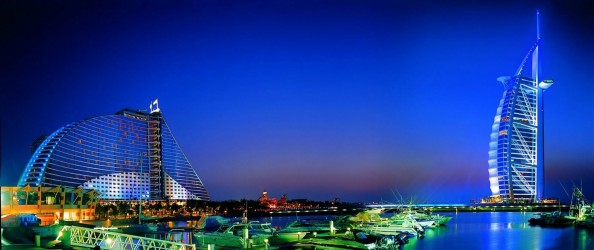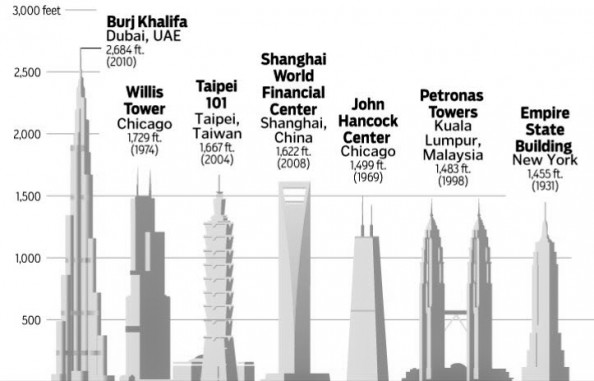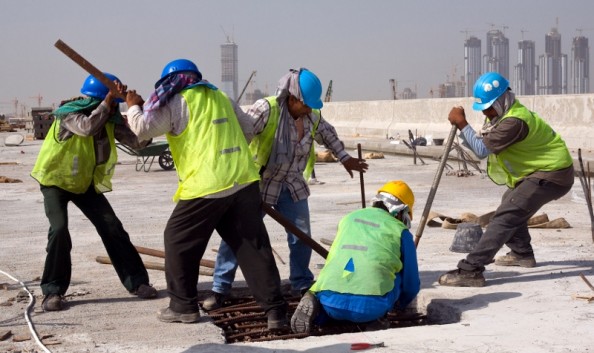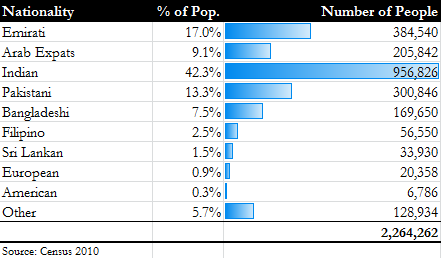Dubai: The Good, The Bad and The Ugly
September 25, 2011 Shem Radzikowski 4 Comments

No matter where you live in Dubai, there are certain things that you can’t get away from — some more annoying than others — irrespective of how hard you try.
For instance, there’s the low hum of nearby freeway traffic, which, to the untrained ear, could be confused with waves crashing on the adjacent beaches. Sadly though, the water is mostly quite still, warm, and uneventful — akin to a bathtub without the bubbles — where one is forced to play with rubber ducks as a replacement for naturally-aspired excitement; a comparison not that dissimilar from Dubai after all. Of course, you can always run away towards the tranquility of the inland dunes.
There’s also the inescapable proliferation of air-conditioned buildings as well as the house-size cooling units mounted on top the huge structures whose temperatures — usually set to frosty — they moderate. Most of the time I’m freezing and wish for my beanie and cut-off finger gloves. My typing speed seems to slow down in proportion to the amount of blood circulating in my hands.
Unlike most cities where growth was organic and gradual, construction here has predominantly occurred along either side of the newly-built mega-freeways. And for all the flyovers and turnpikes, navigating the city is a nightmare of epic proportions. If you miss your turnoff, you’ll have to drive to the next turnpike — some kilometres away — perform a U-turn and try again.
Perhaps, if petrol prices weren’t controlled here, city planners would have a different set of directives to follow? This isn’t the American dream, this is the American nightmare.
Admittedly, the new metro is quite functional and efficient, as is the bus system, although the routes need to be expanded outside tourist sections to be of benefit to the low-income demographic.
Some of my friends have fondly dubbed Dubai, The Sandpit. Truth be told — although surrounded by sand — the city itself is nothing like a sandpit.
Its glass-clad skyscrapers, glittering apartments, modern infrastructure, delectable restaurants tastefully set amongst oases, seem like a modern man-made paradise with all the mod-cons.

World’s Tallest Buildings Side by Side
Dubai is home to the world’s tallest building, the world’s largest shopping mall, the world’s only palm-shaped property development — built on land reclaimed from the sea — all of these, scream nothing less than unbridled opulence.
Expatriates — in search of the tax free dollar — flock here endlessly, and you can gauge the state of the local economy by the number of cars congesting the ten-lane freeways.
Many locals remember the 2008 financial crisis, when the expats in their droves moved off in search of greener pastures; in those days, the word freeway actually stood for something. Today, a trip to old-Dubai resembles congestion only seen in central Nairobi minus the overcrowded matatus.
With their exodus, so collapsed the lucrative, and inflated, real estate market. Some properties lost 40-60% of their value, and many who had purchased luxurious beach-fronted mansions, were now stuck with Dubai-style jumbo mortgages and nobody to offload them to.
But so far, we’ve only touched on the white-collar professionals who command those hefty wages and who can actually enjoy the fruits of their Dubai-based employment.

Dubai’s Construction Workers
There is another, less-glitzy, side to Dubai’s expatriate population — the hundreds of thousands Indian, Sri Lankan, Bangladeshi, Filipino and Pakistani workers who keep Dubai ticking to the tune of a Swiss watch. These are the construction workers, garbage collectors, shop assistants, tailors, cooks, taxi drivers, cleaners, gardeners, and the list goes on. Collectively, they account for almost 70% of Dubai’s population.

Dubai Population Demographic by Nationality

Dubai Population Demographic by Geographic Origin
This darker subculture thrives in the background, out of the way and out of daily conversation, almost transparent. What little they make in the way of wages — although, subsistence living would be a better fit — gets wired back home to feed their families.
I’ve met plenty who live on 800 dirhams a month; enough to pay the rent on a room shared with 10 other colleagues, plus some scraps of food. Dubai isn’t cheap by any stretch of the imagination, and the working subculture is trapped in a vicious circle of covering the rent and providing for their families. Some haven’t been back home for many years, and the toddlers they left behind are now well into their teens.
Complaining about the conditions won’t help you here because there’s plenty of desperate people to take your spot at a moment’s notice. Without a job or a sponsor, your days in paradise are numbered — either you won’t find another job before the visa runs out (if you’re lucky enough not to be locked into the one employer) or you won’t make your rent payment. Both scenarios usually lead to deportation.
Faced with such harsh realities, many work multiple shifts — sometimes dangerously so — and keep their mouths shut.
All too often have my taxi drivers nodded off swerving from lane to lane or caused accidents. In situations like these you end up being torn between your own safety and the driver’s job security — it’s humanly impossible to complain knowing the repercussions.
But for all its glitz and modernity, it lacks in soul and warmth; something quite hard to comprehend about a city where temperatures frequently hit the mid-forties. Even this is slightly warped, as some say that the true temperatures are censored by the government — nothing short of inhumane treatment of outdoor labourers — in order to keep the construction projects on schedule.
And so, life goes on. Dubai is picking up in pace, the expat hiring sprees are in full swing and the freeways aren’t, once again, living up to their names. But the immediate future looks rosy. Plenty of money to attract the masses and lots of sparkling activities to keep them spending. The smart ones — undistracted by the brightly-lit gold bullion — stick around long enough to amass a sizeable nest-egg, and eventually leave to live out their true dreams.
Living in a place where people come and go as frequently as they do in Dubai, is like living in a backpacker dormitory. Each day you make new acquaintances, spend some quality time getting to know each other, perhaps even make good friends. By the morning though, you wake to find only empty beds — at best, new arrivals — and the whole process repeats again. It’s a city in flux, a city of contradictions and to an extent, despair.
Eventually you start to ask yourself: are these characteristics desirable of a place you’d want to call home?
Related
Burj Khalifa, Dubai, Middle East, Money, Population, Tax, UAE, Work Middle East, Thoughts, Travel
4 Comments → “Dubai: The Good, The Bad and The Ugly”
Trackbacks For This Post
-
What do you mean IKEA is a Self-Service Shop? | Dr.Shem -
12 years ago
[…] […]
Leave a Reply
Subscribe
Subscribe and receive email notifications the moment Dr.Shem publishes a new post.
Our Sponsors
Recent Posts
- My Journey with Ropes: Scaling New Heights
- Climbing Mountains in and Around Pokhara: An Adventure Beyond the Summits
- A Nomad’s Notebook: Charting My Path Across Continents
- From Pierogi to Pavlova: My Transcontinental Childhood
- Riding Through History: A Personal Journey on the Irish Rail System
- Above the Azure: Discovering the Thrills of Paragliding in Malta
- Immersed in Nature: A First-hand Experience of Hiking in Wicklow
- My Emerald Isle: Why Ireland is the Epitome of Home
- Life in Boulder Colorado: A Quick Guide to Boulderites’ Lifestyle, Culture, and Values
- The Spirit of Ireland: A Brief History of Irish Whiskey
- Comparison of Firearm Purchase Procedures in California vs Texas
- First impressions on Austin, Texas and its Tech Scene
- Buying a Gun in California – Not as Easy as it Sounds
- Biometric Hype: A Risky Proposition for Fingerprint and Iris Scanners
- Temple Bar: A Great Place to Live, for the Deaf Insomniacs
- Zero Trust and The Mutating Threat Landscape
- CyberSecurity: Expanded Look at the APT Life Cycle and Mitigation
- Mentors: The Priceless Few and Lessons Learned
- Selected by Hackin9 and eForensics Magazines as a Contributing Cybersecurity Expert
- Notes from the Cloud Security Alliance (CSA) Congress EMEA 2015
- Analyzing the Power Consumption of Mobile Antivirus Software on Android Devices
- Poorly Configured Proxies Leaking Information through “X-Forwarded” and “Via” HTTP Request Headers
- CyberSecurity: A Case Study of the Need for Change
- Cyberconfusion: Cyber Security, Cyber-Security or Cybersecurity?
- CyberSecurity: Origins of the Advanced Persistent Threat (APT)
- A Newcomer’s Take on Dublin Town — First Impressions
- Crypto Wars and Messaging: How Secure are Skype and WhatsApp?
- Reduced Cognitive Performance: Open-Plan Offices, Noise and Collaboration
- First Impressions on Working with Huawei’s European Research Center (ERC)
- Lessons I’ve Learnt from various Relationships
- Money and Friends Don’t Always Mix
- X-Pyr 2014: My Annotated Version — An Assistant’s View of the Competition
- Malta Airport Gives Schengen a Slap in the Face
- Officially Selected for the X-Pyr 2014 Competition to Cross the Pyrenees by Paraglider
- A Scuba Diver Never Loses His Stripes
- I’ve Reached Middle Age, or so they say, welcome to the Fabulous Forty (40)
- Dubai Residency Visa: Medical & Blood Tests are a Waste of Time
- Pay-to-Volunteers: A Sad State of Affairs in Africa
- Malaria: Arguably the only African natural resource unwanted by the rest of the world
- Still No Conclusive Evidence Suggesting Syrian Government Used Chemical Weapons
- Will it take one million casualties in Syria before the West gets involved?
- Taking Advantage of Idiosyncrasies and Body Language during Business Meetings and Difficult Situations
- Dubai Holds Great Earning Potential for Anglophone East-Africans
- Absence Makes The Heart Grow Fonder — Does it Really?
- Five Thousand Eight Hundred and Sixty-Two Kilometres from Home
- Avoiding Chronic Short-term Memory Loss on Large Projects
- Invited to Talk about Achieving Enjoyment at Work
- Shove your Hello Tomorrow and give me my Quiet Today
- Professional Certifications: Why get certified in the first place?
- Critique of Media Coverage on BlackBerry’s Share Price Free-fall

I totally agree, I’m living there since six months and still not accustomed to see all these contradictions, and yet I find that it is a city which gives a faithful miniature representation of all the world injustices and the unequal distribution of wealth and pain schema that this world offers to us and unfortunately we are all again eating from this bread (Algerian proverb), that’s why Bad, good and Ugly are always in inverse proportionality relation in here.. whereas i love all the good and tasty food in Dubai restaurants…
Indians seems to be everywhere. surprisingly i do not see chinese in your list. however i must say one thing and we know, you like Africa the best… so move back…
Your report is excellent really I like it and I used some of the information for my project research, you wrote from your deepest heart which is true. (I love Dubai from my Soul)
Wish you the best
Emarti Women